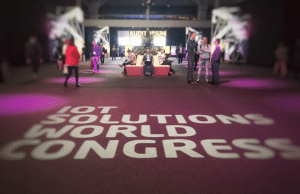The sustainable event trend is continuing to grow and is not showing any signs of stopping. Our planet, as well as congress and conference attendees, expect more from us in terms of protecting natural resources, reducing waste and giving back. The unfortunate fact is that events cause quite a lot of waste. An average conference attendee produces about 1.89 kg of waste per day*, which accumulates to 5.67 kg of waste over a three-day conference and sums up to 5.600 kg of waste for 1.000 conference attendees. Luckily, there are a variety of different areas you, as an event planner, can make changes in, from materials used to catering and overall event production. If you are ready to embark on the sustainable event trend and start implementing green measures at your events, keep reading for 7 feasible ways to make events more environmentally friendly.
*according to meetgreen.com
Go paperless
Going paperless is an easy first step towards sustainability, which will also cut your costs. Digital technology means that events no longer need to generate tons of printed material. Start by making it easy for your attendees to go paperless. Rather than sending paper invitations and tickets, send e-mail invitations and set up digital ticketing. Instead of printing thousands of copies of the program, make digital agendas available, or go one step further and use an event application to communicate all the essential information about the event. On the event floor, you can think about designing reusable signage, that can easily be used again at a later event. For workshops and lectures, abandon the old-fashioned flip charts and use digital or erasable whiteboards instead.
When it comes to items that cannot be replaced by digital versions, such as name badges, make sure they are recyclable and provide visible recycling stations at the end of the event.
Go plastic-free
Plastic is the material everyone has been trying to get rid of recently, as going plastic-free is a highly visible statement and it drastically cuts the amount of waste at an event. It is also an easy practice to implement. For coffee breaks and meals, use reusable utensils, cups, and plates. Do not hand out plastic water bottles and individually wrapped items to participants. Instead, place glasses and water pitchers in the meeting space. You can also encourage attendees to carry a reusable water bottle and refill it throughout the day.
Rethink transportation and location
The location and transportation at your event can create some big opportunities to cut down on your carbon footprint. Think about how the attendees are getting to and from the event. Organize shared transfers for people coming into airports or train stations or utilize public transport. Organizing a shuttle service from a few main pickup points can also reduce the use of cars. Another option is thinking about introducing a car share system for delegates who have to drive to share the journey and their carbon emissions. This is also a great way to help attendees connect before the event.
Hosting the event and lodging in the same hotel, if possible, cuts the need for transportation and greatly reduces the event’s carbon footprint. The same goes when considering an easily walkable destination for your event. Using a venue in a 1-kilometre radius of the hotels in use and a walkable distance from a variety of restaurants and shops would highly decrease the need for transportation.
Be seasonal and reduce waste
Food is something you can easily influence as an event planner. Try incorporating as much seasonal, local and organic food in your menus as possible and find appropriate catering partners, who share this vision. To further reduce the impact of food and beverage you can take some extra measures. For example, you can serve condiments such as sugar in bulk and avoid individual packaging. Another idea is to introduce a Meatless Monday Menu, which alleviates your event of a fair amount of carbon production, associated with the meat industry.
Events are also notorious for wasting food. Understandably, you want to make sure that there will be enough food to go around, but there are better options for leftover food than throwing it out. You can consider contacting local charity programs and arrange to donate leftovers to those in need, be it the homeless, soup kitchens or even college students.
Rethink energy
Energy is another area that is most often not used efficiently yet can easily be optimized when arranged with the venue. Energy waste can be reduced by making sure lights, heating or air conditioning are turned off when rooms are empty. Another simple step is ensuring that all the audio-visual equipment enters a power-saving mode when it is not in use. Additionally, you can utilize in-room motion sensors at the venue, which ensure lights are turned off when the meeting space is not in use.
A further measure of a greener event would be switching to LED lighting. LED lighting is the most energy-efficient, cleanest and most eco-friendly way of illumination. It is incredibly versatile and can create a variety of atmospheres, without negatively impacting the environment.
Choose projection over print
Set and stage design can require large amounts of material, a lot of which cannot be reused at a later occasion. A much greener alternative to physical sets is projection mapping, which uses video projection to eliminate the cost of producing one-off designs by transforming almost any surface into a display. It is not about projecting your content onto a screen, it’s a new engaging method that can transform any simple object into something new and spice up the delegates’ experience. You can design creative and dynamic displays and transport your guests from an exhibition hall to anywhere you want, like a rainforest or Mars, and create interactive experiences, all without the need for weighty sets and props.
Purchase carbon credits
As discussed, various practices can be put in place to make an event greener. However, none of the above-mentioned strategies will make an event 100% green or sustainable. But there is one measure to render your event carbon neutral – purchasing carbon credits. Various companies offer the service of purchasing carbon credits to offset your emissions, as an individual, company, or after holding an event. By purchasing carbon credits, you take responsibility for your respective impact on the climate and help reduce greenhouse gas emissions. The money paid for carbon credits goes towards projects that reduce emissions elsewhere, such as wind farms or methane capture projects, therefore a carbon credit represents a direct investment in the transition to a low-carbon economy.
The mechanism is fairly simple. You start by using an online calculator to calculate the carbon footprint of your event by providing accurate information about the travel, commuting, venue, water and meals associated with your event. The calculation then informs you about the total carbon footprint of your event and lets you redeem yourself by purchasing the offset in carbon credits.














